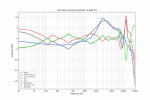Hello! I recently tried to EQ my IEMs to Crinacle/Headphones.com's 5128 Diffuse Field target using AutoEQ, but the treble region doesn't 100% match and I want it to be 100% matched because that's the point of the 5128 rig. What command line can I use to make Auto EQ 100% follow the compensation curve? I already tried messing around with --treble-f-upper, --treble-f-lower, --thread-count, --treble-gain-k. It gets close, but not 100%. Thanks in advance!
-
WANTED: Happy members who like to discuss audio and other topics related to our interest. Desire to learn and share knowledge of science required. There are many reviews of audio hardware and expert members to help answer your questions. Click here to have your audio equipment measured for free!
Forcing AutoEQ to 100% follow the compensation curve?
- Thread starter Volutrik
- Start date

